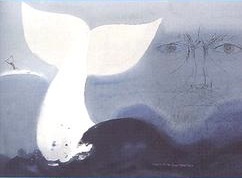Mar 03 2010
What’s Behind an Image?

Shown here is the image found on the cover of the 1998 Signet Classic version of Herman Melville’s Moby-Dick. The image is entitled “Pursuit of the Great White Whale” and was done by Claus Hoie in 1988. Unfortunately, I was unable to find an image any larger than this one, so I would like to point out some aspects of the image before going any further. In the mid to upper left, one can see a harpooner in a boat with the harpoon raised and ready to be thrown at the whale. The line connecting the harpoon to the whalers is visible. In the lower right, the title of the painting is written in white.
As for actually making any sense out of this image … Well, isn’t part of the beginnings of the analysis of any book an analysis of its author?
Claus Hoie was born in Norway in 1911. He moved to Brooklyn, NY at the age of 13 and studied the arts at the Pratt Institute and the Art Students League in New York. Both his father and his grandfather were ship captains, and Hoie himself spent two years at sea. Hoie was a sergeant in the Army during WWII in a Norwegian-American battalion. Following WWII, Hoie studied art in Paris at the Ecole des Beaux Arts. Hoie’s work is mainly in the form of watercolors and graphics, although he has done some commercial work. He has received multiple honors for his art, including awards from the National Academy of Design and the American Watercolor Society. Hoie even wrote and illustrated his own book, entitled Whaler Helena of Sag Harbor in the South Pacific, 1843-1845. His work is on display in multiple museums in the United States and in Norway (information courtesy of http://finearts.luther.edu/artists/hoieclaus.html).
It thus makes sense that such a man would be behind an image that graces the cover of such an epic novel. He has had experience with the sea through both his heritage and his own life, as well as undoubtedly experience with intense conflict and hardship in WWII. What is more intrinsic to Moby-Dick than the sea and conflict? Furthermore, Hoie shows an interest in whaling, evidenced by his publication of Whaler Helena of Sag Harbor in the South Pacific, 1843-1845. The fact that this man, too, experienced with the sea and hardship as Melville was, put considerable effort into the creation of a book about whaling around one hundred years after the publication of Moby-Dick is evidence of how humanity continues to be enchanted with the concept of whaling. It is also particularly interesting to note that the time the book is set in is right around the time that Moby-Dick was published (1851). Furthermore, the fact that the painting on Moby-Dick‘s cover is entitled “The Pursuit of the Great White Whale” shows quite clearly that Hoie created the painting with Moby-Dick in mind, and furthermore, is a tribute to the captivating power that Moby-Dick has had over many different individuals.
Of course, it is possible that Hoie created this piece as a part of his commercially done work, and was requested by someone at Signet to create this painting. However, at the time Hoie created the painting (1988) his career was well-established — he’d been winning awards for his art since 1955. Even if Hoie was asked to create this, it is interesting that he chose to accept this commission. Between Hoie’s interest in the sea and whaling, and his experience with intense great conflict and suffering, he must have been intrigued by creating a cover for Moby-Dick. Furthermore, the image itself shows that the artist has great knowledge of the themes and content of Moby-Dick. The great white whale’s tail is shown, stark and powerful over the depths of the ocean, showing Moby-Dick’s power, but also his beauty. The harpooner, tiny and perched perilously at the top of a wave, shows man’s contrasting powerlessness when compared to the whale. The face etched in the right side of the image can be tied to multiple characters in the novel — is it Ahab, who oversees and controls the fate of The Pequod? Or is it some form of God, who controls fate even more so than Ahab? Either way, this image makes it clear that its artist has a deep understanding of the novel.
The fact that this man’s life is so closely intertwined with concepts found in Moby-Dick, and that he made the effort to create an image that represents the novel so well, over one hundred years after its publication, is just another instantiation of the universality of this novel. People can connect to it, see their own lives in it, reflect back about it… The image on the cover is not some random picture of a whale some Signet editor dug up somewhere — some man whose life is unarguably connected to the book itself chose to put forth the time and effort to create an image that so clearly represents the essence of Moby-Dick.
Leave a Reply
You must be logged in to post a comment.